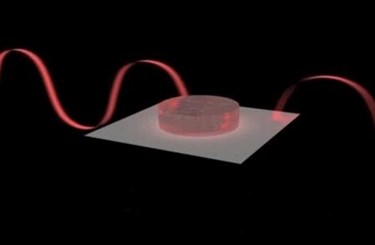Finnish Researchers Use Plasmonic Nanolaser In Dark And Bright Modes
By Jof Enriquez,
Follow me on Twitter @jofenriq

Researchers at Aalto University in Finland have demonstrated for the first time a new lasing technique operating at visible light frequencies, in both bright and dark modes, by utilizing metallic nanoparticles arranged in a periodic array. Their findings make possible the creation of small and ultrafast on-chip light sources.
Conventional lasers rely on mirrors to provide feedback of the lasing signal. However, the Finnish team's laser uses radiative coupling between silver, 100-nanometer-sized nanoparticles instead. These nanoparticles, acting as miniature antennas, are arranged in a lattice structure. Atop the nanoparticles were added organic fluorescent dye molecules, which were used to pump the input energy that is needed for lasing. The distance between the nanoparticles was matched with the lasing wavelength so that all nanoparticles of the array radiate high-intensity laser light simultaneously – a bright mode.
However, laser light in these nanodimensions may be too short-lived to be useful, bouncing just a few hundred times. But the researchers found a workaround: a so-called dark mode, which happens when light is captured by opposite oscillations.
“A dark mode can be intuitively understood by considering regular antennas: A single antenna, when driven by a current, radiates strongly, whereas two antennas – if driven by opposite currents and positioned very close to each other – radiate very little,” explains Academy Professor Päivi Törmä in a news release. “A dark mode in a nanoparticle array induces similar opposite-phase currents in each nanoparticle, but now with visible light frequencies.”
The laser light is trapped inside the nanoparticles, which do not radiate in dark mode, but the edges of the small, finite-scaled array serve as the "escape route" for the light.
"The dark-mode out-coupling mechanism that we introduce is not simple scattering or leakage from sharp edges of the system, rather, it is gradual, coherent build-up of dipole moments and radiation intensity. This inspires ideas for the design of not only out-coupling schemes but also beam guiding, trap potentials, topologically non-trivial lattices and edge modes, for instance by gradually changing the pitch and by particle shapes supporting higher order multipoles," explain the researchers in their study, published in Nature Communications.
Their scientific work opens a route to utilize all modes of plasmonic lattices, and for studies of strong light-matter interactions, condensation and photon fluids, according to the research team at Aalto University, who used the nanofabrication facilities and cleanrooms of the national OtaNano research infrastructure for their nanolaser experiments.
